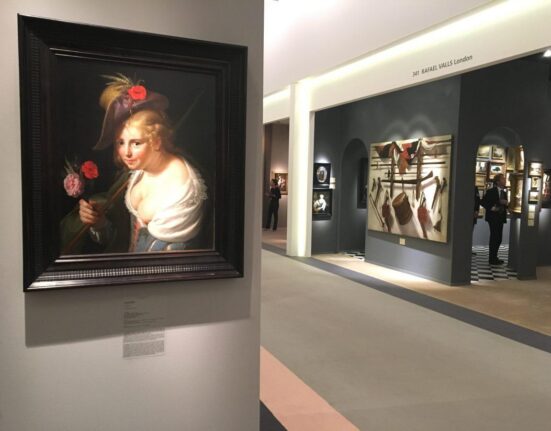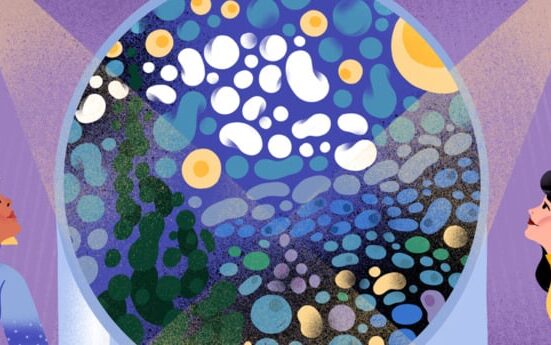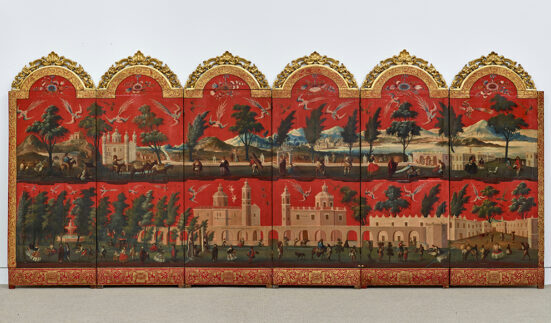A walk down Santa Fe’s iconic Canyon Road can feel more like visiting a mellow art fair than a contemporary art district. Just 10 minutes by foot from the city’s central plaza, the tree-lined thoroughfare features 82 galleries—many of which are housed in adobe-style structures that were built as far back as the mid-1700s—showcasing everything from traditional Pueblo pottery to Southwestern landscapes, and even the occasional Picasso.
Over its six-decade history, Canyon Road has helped New Mexico’s capital achieve a reputation as a leading art and culture destination in the U.S. Despite being a major attraction for the 1.5 to 2 million travelers who flock to Santa Fe annually, the district has managed to maintain its small-town ambiance and reputation as a sanctuary for blossoming artists. Gallery owners describe it as a “magical place” and a “fairy tale of contemporary art.”
“Even though it’s not the kind of high-pressure urban hip place like New York, it has that slow, deep, rich history of artworks that have proven to be some of the most well-collected artists of history,” said Tonya Turner Carroll, co-owner of Turner Carroll Gallery. The presence of pioneering artists such as Judy Chicago, Georgia O’Keeffe, and Agnes Martin—all of whom have created work in Canyon Road studios—still lingered when Turner Carroll Gallery first opened in 1991. “It had that real sense of the greatness and the gravity of history, and with that, a certain responsibility,” she added.
Like Santa Fe itself, Canyon Road’s history is one of intertwined cultures and artistic inspiration. At the turn of the 20th century, the region’s clean air, notorious quality of light, and picturesque landscapes drew creatives and unconventional thinkers from near and far. Painters of the Santa Fe Art Colony—Olive Rush, Sheldon Parsons, and Gerald Cassidy among them—all resided along Canyon Road and helped to shape the city’s advancing creative community.“The thing that I hear most often” from first-time visitors to Canyon Road, said Lawrence Matthews, owner of Matthews Gallery, “is, ‘We had no idea that there was this kind of diversity of work here.’” Southwestern landscapes and bronze-carved moose sculptures are commonplace, but visitors can also come face to face with paintings by Marc Chagall and Philip Guston, or monumental sculptures by Rose B. Simpson. Specializing in modern and contemporary works on the secondary market, Matthews Gallery has handled the estates of numerous artists tied to the region, including New Mexico modernist Janet Lippincott and Abstract Expressionist Robert Walters
Karla Winterowd, another gallery owner and organizer in the Canyon Road community, pointed to the values Santa Feans cherish as an important factor in understanding the culture—and art—of Canyon Road. “They value spirit, they value nature, and they value human connection,” she said. While the vast majority of artist studios that once dotted Canyon Road have disappeared, authenticity and pride in exhibiting artists are shared among gallery owners.
Nüart Gallery offers a prime example of the artist-first ethos that permeates Canyon Road. Juan Kelly, the gallery’s Costa Rican co-owner (and a painter himself), told Artsy that he can’t imagine living anywhere else. “There’s a really strong creative energy here and it’s because you can make a living as an artist,” he said. With rotating shows every two and a half weeks and 3,000 square feet of space, Nüart Gallery showcases virtually every artist in its stable at once. “It’s part of our model,” said co-owner Kim Kelly. A changing display “pushes artists,” she said, incentivizing them “to produce more work and to try new things.”
For Robert Casterline, partner at Casterline Goodman, part of the attraction of Canyon Road was its collectors, many of whom are only beginning to grow their collections. “In Santa Fe, you can take risks,” he said, whereas in Aspen, Colorado, where the gallery has another branch, “I have to be right all the time.” Looking to expand outside of Colorado, Casterline Goodman partnered with Canyon Road’s Blue Gate Gallery in 2021 and has sold secondary-market works in Santa Fe with “great success” ever since. “The thing about Canyon Road,” said Casterline, “is if you have a good space, and you know the rent is affordable, you can have fun with it.”
Like Casterline, who “stands behind” the work that he loves, Ventana Fine Art’s owner Connie Axton—whom Winterowd called the “grand dame” of Canyon Road—looks for “honesty” in an artist’s work. “I want somebody to look at that painting and say, ‘Oh, that’s a John Nieto,’” Axton said. “I don’t want it to look like anybody else.” Bold primary colors spill from Nieto’s Fauvist-inspired portraits of Indigenous people and wildlife, making them distinctly identifiable. Since 2021, Axton estimates that a “huge” 70–80% of Ventana Fine Art buyers have been new to the gallery.
Bolstered by the recent opening of the contemporary art museum Vladem Contemporary, Canyon Road is likely to see more first-time visitors. The Canyon Road community is proud of its history as a supporter of Indigenous American artists. In Turner Carroll’s current exhibition “Transcendent,” presented in conjunction with Vladem Contemporary, the New Mexican ceramist Virgil Ortiz (Cochiti Pueblo) is presented alongside Anglo artists like Angela Ellsworth. “We’re leveling the playing field by not siloing them,” said Turner Carroll, “not siloing people like him as a Native American.”
Overwhelmingly, Canyon Road galleries embrace the fact that the appeal of Santa Fe has spread, believing the street’s artistic integrity is unlikely to fade. As Santa Fe’s Mayor, Alan Webber, made clear, one characteristic of the so-called “The City Different” will continue to define it: “We make art, we promote art, we market art—but most importantly, we live art. That’s in our DNA as a community and as a people,” he said.






